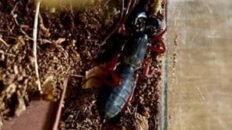Part of our job as a zookeeper is feeding the animals. This involves ensuring they get the right types of food but also the right amount. How much we feed them is influenced by the time of year. Some may need to have more over winter as it is colder while others go into a state of torpor (their activity level slows down a lot so they require less food). Age also has a large impact on them; we have a large number of older individuals on the section now who’s weight needs to be closely monitored.
Body condition
Body condition scoring is used in most animal keeping facilities. In basic terms it uses an image of a species in different weight categories so a keeper can compare their animal with them. More advanced versions will add on markers for key points to look at when comparing. Examples of these are ribs, pelvic bone and the neck. With some of the animals that are safe enough to get close to and don’t mind being handled, they can be combined with actually touching the animal’s body to see if for example, the ribs are easily palpable meaning there is not a large fat content covering them. With the carnivore section however, most of them we have protected contact with meaning we can’t get hands on with them. Even most of the smaller species are too feisty for us to get too close to.
Scales training
With training however, as you will have seen from Georgia’s (Head of Training) blogs we can get the animals to do things safely that benefit them. Training them to get onto a set of scales means we have a record of their actual weight meaning we can check if they are losing or gaining, if this is happening over a short period of time. We can even use this if we suspect an animal is pregnant or if we know they are, we can monitor the mother’s weight to see that they are gaining at a suitable rate. Getting them to go onto the scales of their own accord means there is no risk of stressing the mother out in a delicate condition.
We have a long list of individuals on our section that successfully get onto the scales. Some simply get on without batting an eyelid while others we have had to think outside the box to get a good weight. So let’s have a look at some now.
Raccoon dogs
The raccoon dogs are probably the most shy individuals on Carnivores. We have however, managed to scales and crate train Pika our female and are currently working on the male Bob to bring him out of his shell. Being able to get a weight off her does mean we have an idea for him so helps for planning diets.


Caracal
Maya the caracal has been doing scales training for a while now and so needs very little encouragement. As soon as she sees the scales in her nest box she gets straight onto them. She even lies down and will stay still for an extended period of time which allows us to get the most accurate weight possible. Clever girl!


Asian short-clawed otters
Jill and Storm are our Asian short-clawed otters are definitely mischievous! With these two it’s important to keep an eye on both of them. A favourite tactic of Storm’s is to come up behind you while you are distracted by Jill. Cheeky!
They’re very good at getting on the scales. In fact the real trick is getting one at a time. Jill will even lie down on them while eating her treat.



Amur leopard
Our most recent to get onto the scales was Kaia the Amur leopard. She’s an older cat now and so monitoring her weight is very important.
You can’t quite see the scales on this picture but sat on the scales perfectly. As you can see, she more interested in the photographer than the new object she’s standing on.


Moon bears
Mika our female bear, was tentative about getting on the scales at first and spent a bit of time seeing if she could get the peanut butter off me by going round them.
Once that plan failed and she realised I wanted her to get onto them it was a different story. She proved to be a professional and sat on them a good while.
That’s a hard working tongue ensuring nothing is left on the mesh.




So next time you are in the park you may just see a keeper going past with their scales. Try and guess who is on their list!
Source: winghamwildlifepark.co.uk







 Please wait...
Please wait...

Add comment